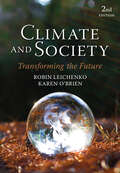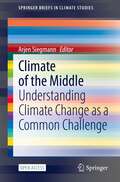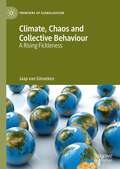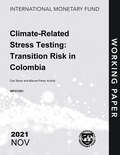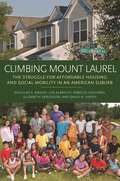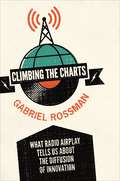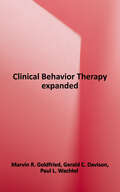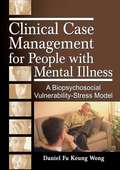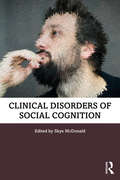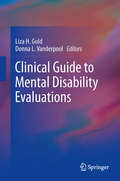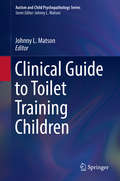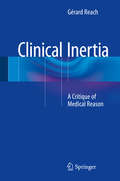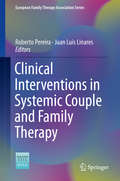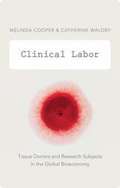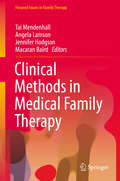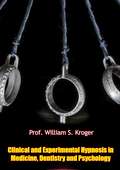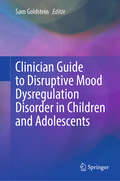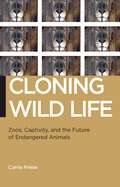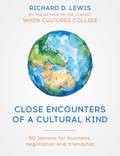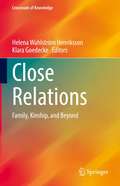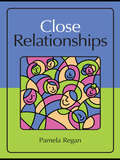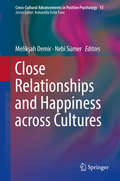- Table View
- List View
Climate and Society: Transforming the Future
by Karen O'Brien Robin LeichenkoThis bold and passionate textbook has become a go-to introduction to current and emerging thinking on the social dimensions of climate change, presenting key concepts and frameworks for understanding the multifaceted connections between climate and society. Using clear language and powerful examples, Robin Leichenko and Karen O'Brien explore the varied social drivers, impacts, and responses to climate change. They highlight the important roles that worldviews, values, and – especially in this updated edition – emotions play in shaping interpretations of climate challenges. They include additional material on climate justice and equity, eco-centric discourses, paradigm shifts, and other topics. Situating climate change within the context of a rapidly changing world, the book demonstrates how dynamic political, economic, and environmental contexts amplify risks, often unequally for different groups based on race, gender, wealth, and location. Yet these shifting conditions also present opportunities for transformative responses: the new edition strengthens its emphasis on individuals’ power to influence systems, structures, and cultures. With updated references, examples, and data, and expanded pedagogical features, this informative and engaging new edition empowers undergraduates across the social sciences and other disciplines with a broader and deeper understanding of climate change and the potential for equitable and sustainable responses.
Climate of the Middle: Understanding Climate Change as a Common Challenge (SpringerBriefs in Climate Studies)
by Arjen SiegmannThis Open Access book presents a multidisciplinary perspective to increase our understanding of climate policies that are rooted in the natural moral inclinations of people, families and firms. Which policies prevent a widening gap between higher and lower educated people? Which policy instruments are there, and how could they be used? What is the role of free entrepreneurship?In this book, academics from different fields have brought together their knowledge and expertise to reflect on the following three questions: How are the polarised positions on climate change of different groups related to their moral outlook, world view, tradition, cultural norms and values? What is a good distribution of responsibilities between firms, households and the government relating to climate change? What are possible avenues where the climate policies are a natural extension of moral inclinations of families and firms, such as the stewardship for the natural environment and the climate? This book will be of interest to policy and decision-makers, students of social and behavioural sciences, and those interested climate change policies and how this effects our lives
Climate, Chaos and Collective Behaviour: A Rising Fickleness (Frontiers of Globalization)
by Jaap van GinnekenThis book introduces principles of Chaos theory (and Complex Adaptive Systems) to social science, in a lively and elegant way. It applies it to the twin disciplines of mass psychology (under social psychology, mostly in Europe) and collective behavior sociology (mostly in North America) that deal with emergent psychosocial phenomena that lie outside conventional approaches. Each of the eleven chapters begins with a topical ‘case study’ section, on an issue related to climate change and collective behaviour, such as the ‘school strike’ by Swedish schoolgirl Greta Thunberg, the Hollywood movie The Day After Tomorrow, and more. This book aims to show that there are fundamental reasons why many phenomena cannot be easily ‘measured, predicted and controlled’, and thus we need to familiarize ourselves with alternative ways of thinking about them.
Climate-Related Stress Testing: Imf Economic Review
by International Monetary Fund. Asia and Pacific DeptA report from the International Monetary Fund.
Climbing Mount Laurel: The Struggle for Affordable Housing and Social Mobility in an American Suburb
by Douglas S. Massey David N. Kinsey Elizabeth Derickson Len Albright Rebecca CascianoA close look at the aftereffects of the Mount Laurel affordable housing decisionUnder the New Jersey State Constitution as interpreted by the State Supreme Court in 1975 and 1983, municipalities are required to use their zoning authority to create realistic opportunities for a fair share of affordable housing for low- and moderate-income households. Mount Laurel was the town at the center of the court decisions. As a result, Mount Laurel has become synonymous with the debate over affordable housing policy designed to create economically integrated communities. What was the impact of the Mount Laurel decision on those most affected by it? What does the case tell us about economic inequality?Climbing Mount Laurel undertakes a systematic evaluation of the Ethel Lawrence Homes—a housing development produced as a result of the Mount Laurel decision. Douglas Massey and his colleagues assess the consequences for the surrounding neighborhoods and their inhabitants, the township of Mount Laurel, and the residents of the Ethel Lawrence Homes. Their analysis reveals what social scientists call neighborhood effects—the notion that neighborhoods can shape the life trajectories of their inhabitants. Climbing Mount Laurel proves that the building of affordable housing projects is an efficacious, cost-effective approach to integration and improving the lives of the poor, with reasonable cost and no drawbacks for the community at large.
Climbing the Charts: What Radio Airplay Tells Us about the Diffusion of Innovation
by Gabriel RossmanHow songs achieve commercial success on the radioDespite the growth of digital media, traditional FM radio airplay still remains the essential way for musicians to achieve commercial success. Climbing the Charts examines how songs rise, or fail to rise, up the radio airplay charts. Looking at the relationships between record labels, tastemakers, and the public, Gabriel Rossman develops a clear picture of the roles of key players and the gatekeeping mechanisms in the commercial music industry. Along the way, he explores its massive inequalities, debunks many popular misconceptions about radio stations' abilities to dictate hits, and shows how a song diffuses throughout the nation to become a massive success.Contrary to the common belief that Clear Channel sees every sparrow that falls, Rossman demonstrates that corporate radio chains neither micromanage the routine decision of when to start playing a new single nor make top-down decisions to blacklist such politically inconvenient artists as the Dixie Chicks. Neither do stations imitate either ordinary peers or the so-called kingmaker radio stations who are wrongly believed to be able to make or break a single. Instead, Rossman shows that hits spread rapidly across radio because they clearly conform to an identifiable style or genre. Radio stations respond to these songs, and major labels put their money behind them through extensive marketing and promotion efforts, including the illegal yet time-honored practice of payoffs known within the industry as payola.Climbing the Charts provides a fresh take on the music industry and a model for understanding the diffusion of innovation.
Clinical Applications of Linguistics to Speech-Language Pathology: A Guide for Clinicians
by Naomi Gurevich Christopher M. GrindrodClinical Applications of Linguistics to Speech-Language Pathology is a practical guide that provides linguistically grounded approaches to clinical practice. It introduces key linguistic disciplines and discusses how they form a basis for assessment and treatment of individuals with communication differences or disorders. Written by experts in linguistics and communication disorders, each chapter provides clinicians with a foundational understanding of linguistics as it applies to spoken and signed languages and underscores the importance of integrating linguistic theories into clinical decision-making. The book is divided into two parts that focus on the applications of linguistics to speech and language differences and disorders in both children and adults. The chapters cover the full range of linguistic domains including phonetics, phonology, morphology, syntax, semantics, pragmatics, and sociolinguistics. Applications to a wide range of populations including childhood apraxia of speech, aphasia, dysarthria, traumatic brain injury and accent modification clients are also discussed. Many chapters include assessment and treatment resources that can be used by practicing clinicians. This highly accessible and comprehensive book is an indispensable resource for practicing speech-language pathologists and other members of the profession, including instructors with minimal exposure to linguistics. It will also be beneficial for students of Linguistics, Speech and Hearing Sciences, and Audiology and Speech Language Pathology who are seeking practical knowledge of the fields.
Clinical Assessment and Diagnosis in Social Work Practice
by Jacqueline Corcoran Joseph WalshThis tightly focused textbook will help clinical social workers not only develop competence in the Diagnostic and Statistical Manual (DSM-IV-TR) system of diagnosis, it will also assist them to stay attuned during client assessment to social work values and principles -- a focus on client strengths, concern for the worth and dignity of individuals, appreciation of environmental influences on behavior, and a reliance on evidence-based approaches.
Clinical Behavior Therapy, Expanded Edition
by Gerald C. Davison Marvin R. GoldfriedCritical Acclaim for Clinical Behavior Therapy "This book will be helpful not only to those who regard this [cognitive-behavior therapy] as their primary orientation, but to anyone who wants to be a complete therapist." --Allen Frances, MD Duke University Medical Center "This classic text. was a distinct favorite among the students enrolled in my clinical assessment and treatment courses. I hope the updated edition will be read by graduate students in clinical and counseling psychology, social workers, and all mental health professionals who wish to be truly effective therapists." --Arnold A. Lazarus, PhD Rutgers University ". particularly innovative and impressive. Their lucid description of cognitive variables. broadens the range of interventions available to the behavioral practitioner."-Sheldon Rose, PhD, University of Wisconsin School of Social Work "A classic--updated. I recommend it not only for behavior therapists but for any clinical practitioner of any profession who is looking for procedures that work." --Joel Fischer, DSW University of Hawaii at Manoa
Clinical Case Management for People with Mental Illness: A Biopsychosocial Vulnerability-Stress Model
by Daniel Fu WongA unique-and effective-approach to mental health practiceClinical Case Management for People with Mental Illness combines theory, practice, and plenty of clinical examples to introduce a unique approach to case management that&’s based on a biopsychosocial vulnerability-stress model. This practice-oriented handbook stresses the dynamic interplay among biological, psychological, social, and environmental factors that influences the development-and severity-of a person&’s mental illness. Filled with case examples to illustrate the assessment and intervention process, the book is an essential resource for working with people who suffer from depression, anxiety disorders, schizophrenia, and personality disorders.Author Daniel Fu Keung Wong draws on his experiences as an educator, cognitive therapist, mental health worker, and case manager working in Asia and Australia to explore the concepts and contexts of clinical case management for individuals suffering from mild and chronic mental illness. He guides you through the creative use of various therapeutic approaches that emphasize different aspects of a person&’s condition that can influence the cause and course of mental illness. Clinical Case Management for People with Mental Illness examines a range of important topics, including the roles and functions of mental health workers, relapse prevention, assessment and clinical intervention, psychiatric crisis management, and working with families. In addition, the book includes checklists, worksheets, activity charts, and three helpful appendices. Clinical Case Management for People with Mental Illness examines: models of assessment microskills in assessment areas of assessment and intervention understanding the roles and psychological reactions of family members assessing and working with individuals with suicidal risk or aggressive behaviors and much more!Clinical Case Management for People with Mental Illness is an essential resource for mental health professionals, including psychologists, occupational therapists, mental health social workers, nurses, counselors, and family social workers.
Clinical Disorders of Social Cognition
by Skye McDonaldClinical Disorders of Social Cognition provides contemporary neuroscientific theories of social cognition in a wide range of conditions across the lifespan. Taking a trans-diagnostic approach to understanding these disorders, it discusses how they present in different conditions, ranging from brain injury to neurodevelopmental disorders, psychiatric conditions and dementia. Social cognitive disorders directly impact upon individuals’ work, leisure and social functioning. This book also collates and critiques the best and most useful assessment tools across the different disorders and coalesces research into intervention strategies across disorders to provide practical information about how such disorders can be assessed and treated so individuals can have meaningful, effective and satisfying social interactions. This book is essential reading for clinicians who work with people with clinical disorders and who are looking for new knowledge to understand, assess and treat their clients with social cognitive impairment. It will also appeal to students and professionals in clinical neuropsychology, speech and language pathology and researchers who are interested in learning more about the social brain and understanding how evidence from clinical conditions can inform this.
Clinical Guide to Mental Disability Evaluations
by Liza H. Gold Donna L. VanderpoolDisability evaluations are the most common clinical mental health evaluations conducted for nontreatment purposes. They place mental health professionals in the role of communicating information that is typically confidential to administrative and legal systems. Unfortunately, mental health professionals receive little to no training in conducting assessments that focus on disability and disability management, and often do not understand the implications and risks of providing this information, especially without conducting what are often specialized evaluations. Clinical Guide to Mental Health Disability Evaluations is geared for general mental health practitioners, providing them with the basic information needed to competently provide the various types of disability evaluations. It also provides enough information to inform forensic mental health providers in conducting more specialized evaluations.
Clinical Guide to Toilet Training Children (Autism and Child Psychopathology Series)
by Johnny L. MatsonThis book offers a comprehensive overview of the universal issue of toilet training in children and explores issues that need to be considered by clinicians and other professionals. The book begins with a historical overview of the field, including origins and reviews of current practices. It discusses various toileting problems and their side effects, risk factors, normal developmental milestones in toileting, and theories of toileting. Chapters identify behavior problems (e. g. , self-injury, noncompliance) as well as medical conditions (e. g. , diabetes, constipation) that can affect continence, with proven strategies for addressing these challenges in toilet training children, including those with intellectual and developmental disabilities. The book concludes with a discussion of the strengths of current toilet training practices as well as suggestions for areas where continued improvement is required. Topics featured in this book include: #65533; Complications and side effects associated with the lack of toileting skills. #65533; Technology used in toilet training. #65533; Applications of operant-based behavioral principles to toilet training. #65533; Toilet training strategies involving modeling and modifications of the physical environment. #65533; Toilet training children with physical disabilities. The Clinical Guide to Toilet Training Children is a must-have resource for researchers, graduate students, clinicians, and related therapists and professionals in clinical child and school psychology, pediatrics, family studies, developmental psychology, nursing, social work, and behavioral therapy/rehabilitation.
Clinical Inertia: A Critique of Medical Reason
by Gérard ReachClinical practice guidelines were initially developed within the context of evidence-based medicine with the goal of putting medical research findings into practice. However, physicians do not always follow them, even when they seem to apply to the particular patient they have to treat. This phenomenon, known as clinical inertia, represents a significant obstacle to the efficiency of care and a major public health problem, the extent of which is demonstrated in this book. An analysis of its causes shows that it stems from a discrepancy between the objective, essentially statistical nature of evidence-based medicine on the one hand and the physician's own complex, subjective view (referred to here as "medical reason") on the other. This book proposes a critique of medical reason that may help to reconcile the principles of evidence-based medicine and individual practice. The author is a diabetologist and Professor of Endocrinology, Diabetology and Metabolic Diseases at Paris 13 University. He has authored several books, including one to be published by Springer (Philosophy and Medicine series) under the title: The Mental Mechanisms of Patient Adherence to Long Term Therapies, Mind and Care. , Diabetology and Metabolic Diseases at the Paris 13-University. He has also published Pourquoi Se soigne-t-on, Enquête sur la rationalité morale de l'observance (2007), Clinique de l'Observance, L'Exemple des diabètes (2006), and Une théorie du soin, Souci et amour face à la maladie (2010). An English adaptation of the first book is published by Springer (Philosophy and Medicine) under the title: The Mental Mechanisms of Patient Adherence to Long Term Therapies, Mind and Care.
Clinical Interventions in Systemic Couple and Family Therapy (European Family Therapy Association Series)
by Roberto Pereira Juan Luis LinaresThis timely update presents modern directions in systemic therapy practice with couples and families, focusing on clinical innovations from Italy, Portugal, and Spain. Top therapists discuss their breakthrough family work in treating familiar pathologies such as depression, borderline personality disorder, infidelity, and addictions, providing first-hand insight into meeting relational dysfunction with creativity and resourcefulness. The book applies novel conceptualizations and fresh techniques to complex situations including multi-problem families, involuntary clients, disability-related issues, anorexia, love and sex in aging, and family grief. From tapping into the strengths of siblingship to harnessing the therapeutic potential of the Internet, the book’s cases illustrate the rich variety of opportunities to improve client outcomes through systemic couple and family therapy.This practical guide: Demonstrates strategies for therapists to improve practiceExemplifies methods for reducing the gap between clinical theory and practiceIdentifies multiple dimensions of systems thinking in case formulation and therapyOffers new insights into treating classic and recent forms of psychopathologyProvides a representative picture of couple and family therapy in southern EuropeClinical Interventions in Systemic Couple and Family Therapy is of particular relevance to practitioners and clinicians working within couple and family therapy, and is also of interest to other professionals working in psychotherapy and professional mental health services.
Clinical Labor: Tissue Donors and Research Subjects in the Global Bioeconomy
by Catherine Waldby Melinda CooperForms of embodied labor, such as surrogacy and participation in clinical trials, are central to biomedical innovation, but they are rarely considered as labor. Melinda Cooper and Catherine Waldby take on that project, analyzing what they call "clinical labor," and asking what such an analysis might indicate about the organization of the bioeconomy and the broader organization of labor and value today. At the same time, they reflect on the challenges that clinical labor might pose to some of the founding assumptions of classical, Marxist, and post-Fordist theories of labor.Cooper and Waldby examine the rapidly expanding transnational labor markets surrounding assisted reproduction and experimental drug trials. As they discuss, the pharmaceutical industry demands ever greater numbers of trial subjects to meet its innovation imperatives. The assisted reproductive market grows as more and more households look to third-party providers for fertility services and sectors of the biomedical industry seek reproductive tissues rich in stem cells. Cooper and Waldby trace the historical conditions, political economy, and contemporary trajectory of clinical labor. Ultimately, they reveal clinical labor to be emblematic of labor in twenty-first-century neoliberal economies.
Clinical Methods in Medical Family Therapy (Focused Issues In Family Therapy Ser.)
by Jennifer Hodgson Angela Lamson Tai Mendenhall Macaran BairdThis landmark text describes research-informed practices and applications of Medical Family Therapy (MedFT) across a range of care environments and clinical populations (e.g., family medicine, obstetrics and gynecology, psychiatry, alcohol and drug treatment, community health centers, and military and veteran health systems). It is a timely release for a rapidly growing field. It includes the work of some of MedFT’s most innovative leaders, who expertly: illustrate MedFT in action across primary, secondary, tertiary, and other unique health contextsdescribe the make-up of healthcare teams tailored to each chapter’s distinct environment(s)highlight fundamental knowledge and critical skillsets across diverse healthcare contextsdetail research-informed practices for MedFTs who treat patients, couples, families, and communities Clinical Methods in Medical Family Therapy is a comprehensive source for any behavioral health student, trainee, or professional looking to understand the necessary skills for MedFTs entering the healthcare workforce. It is also an essential read for trainers and instructors who are covering the fundamental MedFT knowledge and skills across diverse healthcare contexts. This text was written to be applicable for a wide variety of healthcare disciplines, including family therapy, counseling nursing, medicine, psychology and social work.
Clinical and Experimental Hypnosis in Medicine, Dentistry and Psychology
by Prof. William S. KrogerOriginally published in 1963, this definitive textbook, written by pioneering Professor William S. Kroger's, defined and shaped the field of hypnosis for over 20 years after its publication, and remains an authoritative text in its field to this day.Together with his seminars presented in association with the American Society of Clinical Hypnosis, Professor Kroger's textbook changed the perception of hypnosis from being a novelty to a legitimate and respected medical option, and solidified his reputation as a leader in the field.
Clinician Guide to Disruptive Mood Dysregulation Disorder in Children and Adolescents
by Sam GoldsteinThis book examines disruptive mood dysregulation disorder (DMDD) during childhood and adolescence. It explores the ways in which explosive anger outbursts and persistent irritability are among the most problematic symptoms in child and adolescent mental health. and may present as a feature of many different psychiatric illnesses. The volume addresses the myriad challenges that youth with a focus on the DMDD diagnosis experience. Chapters focus on key issues of development, behavior, achievement, social relations, and mood. The book describes how to diagnose and conduct clinical assessments of child and adolescent personality and behavior with suspected DMDD. Key areas of coverage include: Comprehensive history of mood dysregulation research and current trends in psychiatric classification (e.g., DSM-5, Research Domain Criteria) and their influence on the clinical assessment of children and adolescents with suspected DMDD. Updates of professional standards to guide clinicians and diagnosticians and discussions of practical considerations in planning and conducting clinical assessments for children with DMDD. Reviews the most recent editions of questionnaires and tests used in the clinical assessment of child and adolescents with suspected DMDD. Differential diagnosis and practical methods for integrating assessment information to develop an effective, multidisciplinary treatment plan. Review of current trends in psychiatric and psychological treatment of DMDD. Clinician Guide to Disruptive Mood Dysregulation Disorder in Children and Adolescents serves as an essential resource for researchers, professors, and graduate students as well as veteran and early-career clinicians and professionals across such interrelated disciplines as school, clinical child, developmental, and educational psychology, child and adolescent psychiatry, school counseling, social work, and public health.
Clio's Foot Soldiers: Twentieth-Century U. S. Social Movements And Collective Memory (Public History In Historical Perspective Series)
by Lara Leigh KellandCollective memories are key to social movements. Activists draw on a shared history to build identity, create movement cohesion, and focus political purpose. But what happens when marginalized communities do not find their history in dominant narratives? How do they create a useable past to bind their political communities together and challenge their exclusion? <p><p> In Clio's Foot Soldiers, Lara Leigh Kelland investigates these questions by examining 1960s and 1970s social movements comprised of historically marginalized peoples: Civil Rights, Black Power, Women's and Gay Liberation, and American Indian. These movements sought ownership over their narratives to create historical knowledge reflective of their particular experiences. To accomplish their goals, activists generated new forms of adult education, published movement newspapers, and pursued campus activism and speeches, public history efforts and community organizations. Through alternative means, marginalized communities developed their own historical discourses to mobilize members, define movement goals, and become culturally sovereign. In so doing, they provided a basis for achieving political liberation and changed the landscape of liberal cultural institutions.
Cloning Wild Life: Zoos, Captivity, and the Future of Endangered Animals (Biopolitics #14)
by Carrie FrieseThe natural world is marked by an ever-increasing loss of varied habitats, a growing number of species extinctions, and a full range of new kinds of dilemmas posed by global warming. At the same time, humans are also working to actively shape this natural world through contemporary bioscience and biotechnology. In Cloning Wild Life, Carrie Friese posits that cloned endangered animals in zoos sit at the apex of these two trends, as humans seek a scientific solution to environmental crisis. Often fraught with controversy, cloning technologies, Friese argues, significantly affect our conceptualizations of and engagements with wildlife and nature.By studying animals at different locations, Friese explores the human practices surrounding the cloning of endangered animals. She visits zoos—the San Diego Zoological Park, the Audubon Center in New Orleans, and the Zoological Society of London—to see cloning and related practices in action, as well as attending academic and medical conferences and interviewing scientists, conservationists, and zookeepers involved in cloning. Ultimately, she concludes that the act of recalibrating nature through science is what most disturbs us about cloning animals in captivity, revealing that debates over cloning become, in the end, a site of political struggle between different human groups. Moreover, Friese explores the implications of the social role that animals at the zoo play in the first place—how they are viewed, consumed, and used by humans for our own needs. A unique study uniting sociology and the study of science and technology, Cloning Wild Life demonstrates just how much bioscience reproduces and changes our ideas about the meaning of life itself.
Close Encounters of a Cultural Kind: Lessons for business, negotiation and friendship
by Richard LewisRichard Lewis - world famous lecturer on intercultural issues and best-selling author of WHEN CULTURES COLLIDE - has collected 50 unique, critical cross-cultural incidents during his encounters in 135 countries around the globe. Some of these anecdotes are humorous, some are poignant, some are mysterious - all are insightful snapshots of the complex tapestry of cross-cultural business. If you're dining with a Finn, negotiating with the Japanese or attempting to climb a mountain with a team of diffident Italians, you need this book."Historically, 'cultural encounters' have often created wars and split people. In this precious little gem of a book, Richard shows how beautifully cultural barriers can be overcome when people meet face-to-face. How we, despite different outlooks, can build bridges across cultural gaps with mindful, respectful and humorous approaches. The stories, told in a vibrant and captivating voice, ranging from thought provoking and insightful to adventurous and hilarious, are a delightful read. The charming characters of broad cultural variety bring the whole world into your hands, making hearts bond over a jolly good laugh.And frankly, - what can be better?"Marit Imeland Gjesme, Founder of CultureCatch®, intercultural training consultancy
Close Relations: Family, Kinship, and Beyond (Crossroads of Knowledge)
by Helena Wahlström Henriksson Klara GoedeckeThis book speaks to the meanings and values that inhere in close relations, focusing on ‘family’ and ‘kinship’ but also looking beyond these categories. Multifaceted, diverse and subject to constant debate, close relations are ubiquitous in human lives on embodied as well as symbolic levels. Closely related to processes of power, legibility and recognition, close relations are surrounded by boundaries that both constrain and enable their practical, symbolical and legal formation. Carefully contextualising close relations in relation to different national contexts, but also in relation to gender, sexuality, race, religion and dis/ability, the volume points to the importance of and variations in how close relations are lived, understood and negotiated.Grounded in a number of academic areas and disciplines, ranging from legal studies, sociology and social work to literary studies and ethnology, this volume also highlights the value of using inter- and multidisciplinary scholarly approaches in research about close relations.Chapter 11 is available open access under a Creative Commons Attribution 4.0 International License via link.springer.com.
Close Relationships
by Pamela ReganThis multidisciplinary text introduces the concepts, methodologies, theories, and empirical findings of the field of interpersonal relationships. Information is drawn from psychology, communication, family studies, marriage and family therapy, social work, sociology, anthropology, the health sciences, and other disciplines. Numerous examples capture readers’ attention by demonstrating how the material is relevant to their lives. Active learning is encouraged throughout. Each chapter includes an outline to guide students, key terms and definitions to help identify critical concepts, and exploration exercises to promote active thinking. Many chapters include measurement instruments that students can take and score themselves. A website for instructors features a test bank with multiple-choice and essay questions and Power Points for each chapter. This text distinguishes itself with: Its focus on family and friend relationships as well as romantic relationships. Its multidisciplinary perspective highlighting the contributions to the field from a wide array of disciplines. Its review of the relationship experiences of a variety of people (of different age groups and cultures; heterosexual and homosexual) and relationship types (dating, cohabiting, marriage, friendships, family relationships). Its focus on methodology and research design with an emphasis on how to interpret empirical findings and engage in the research process. Cutting-edge research on "cyber-flirting" and online relationship formation; the biochemical basis of love; communication and social support; bullying and peer aggression; obsession and relational stalking; sexual violence (and marital rape); and grief and bereavement. The book opens by examining the fundamental principles of relationship science along with the research methods commonly used. The uniquely social nature of humans is then explored including the impact relationships have on health and well-being. Part 2 focuses on relationship development—from attraction to initiation to development and maintenance as well as the factors that guide mate choice and marriage. The development of relationships in both friendships and romantic partnerships is explored. Part 3 examines the processes that shape our interpersonal experiences, including cognitive (thinking) and affective (feeling) processes, communicative and supportive processes, and the dynamics of love and sex. The book concludes with relationship challenges—rejection and betrayal; aggression and violence; conflict and loss; and therapeutic interventions. Intended as a text for courses in interpersonal/close relationships taught in psychology, communication, sociology, anthropology, human development, family studies, marriage and family therapy, and social work, practitioners interested in the latest research on personal relationships will also appreciate this engaging overview of the field.
Close Relationships and Happiness across Cultures (Cross-Cultural Advancements in Positive Psychology #13)
by Melikşah Demir Nebi SümerThis volume focuses explicitly on close relationships as a reliable source for individual happiness and well-being across cultures. The work in this volume addresses theoretical issues and presents new cross-cultural data in the study of close relationships and happiness. Experts from different parts of the world provide in-depth, authoritative reviews and new findings on the relationship between various types of close bonds (e.g., intimate, marital, friendship, grandparent) and happiness in a variety of cultures. An ideal resource for researchers and students of relationship science and positive psychology, this rich, clear, and up-to-date book serves as an important reference for academicians in related fields of psychology such as cross-cultural, social, and developmental.
